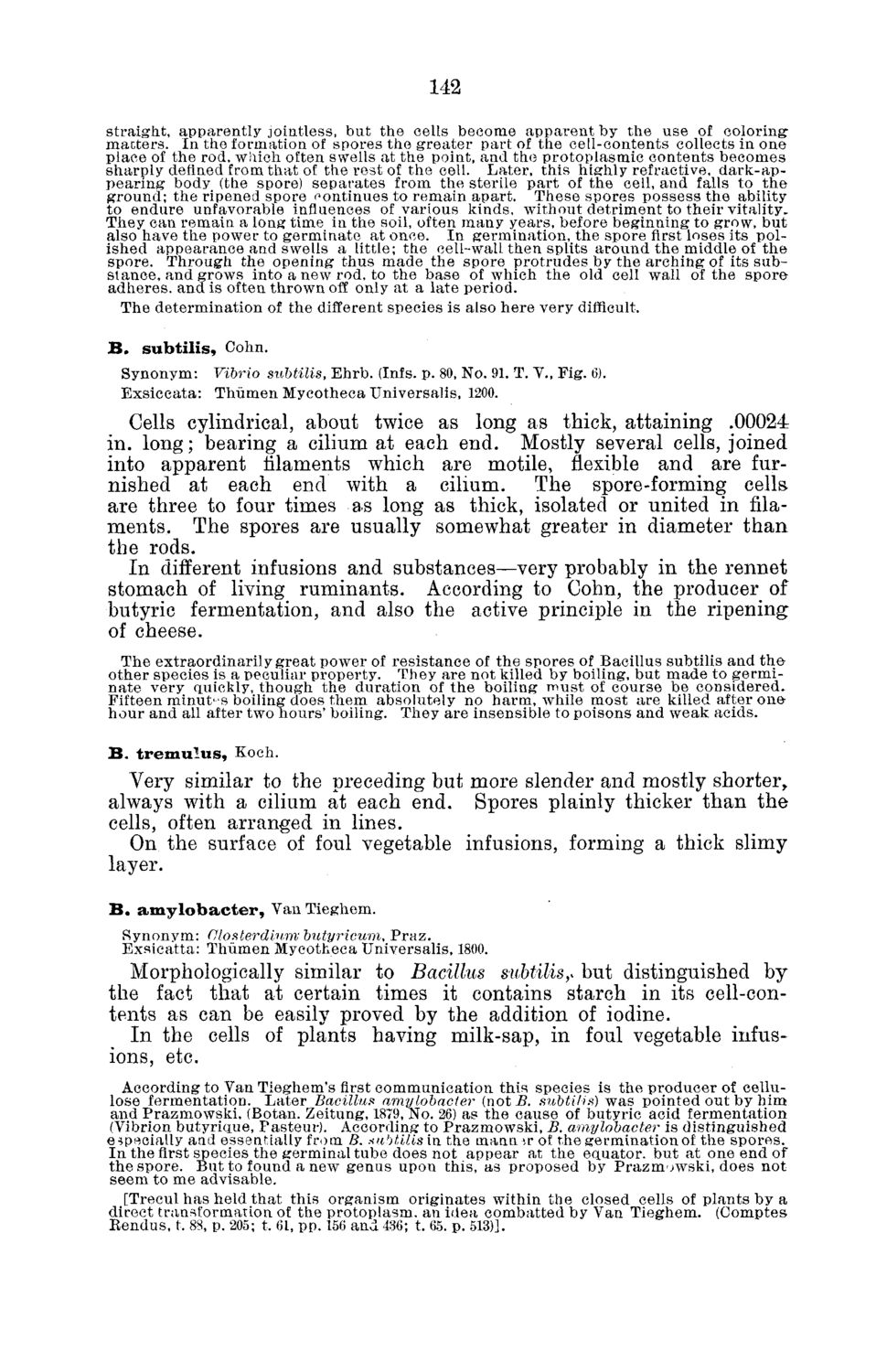| |
| |
Caption: Board of Trustees Minutes - 1882
This is a reduced-resolution page image for fast online browsing.

EXTRACTED TEXT FROM PAGE:
142 straight, apparently jointless, but the cells become apparent by the use of coloring matters. In the formation of spores the greater part of the cell-contents collects in one place of the rod, which often swells at the point, and the protoplasmic contents becomes sharply defined from that of the rest of the cell. Later, this highly refractive, dark-appearing body (the spore) separates from the sterile part of the cell, and falls to the ground; the ripened spore continues to remain apart. These spores possess the ability to endure unfavorable influences of various kinds, without detriment to their vitality. They can remain a long time in the soil, often many years, before beginning to grow, but also have the power to germinate at once. In germination, the spore first loses its polished appearance and swells a little; the cell-wall then splits around the middle of the spore. Through the opening thus made the spore protrudes by the arching of its substance, and grows into a new rod, to the base of which the old cell wall of the spore adheres, and is often thrown off only at a late period. The determination of the different species is also here very difficult. B . s u b t i l i s , Cohn. Synonym: Vibrio subtilis, Ehrb. (Infs. p. 80, No. 91. T. V., Fig. 6). Exsiccata: Thiimen Mycotheca Universalis, 1200. Cells cylindrical, about twice as long as thick, attaining .00024 in. long; bearing a cilium at each end. Mostly several cells, joined into apparent filaments which are motile, flexible and are furnished at each end with a cilium. The spore-forming cells are three to four times as long as thick, isolated or united in filaments. The spores are usually somewhat greater in diameter than the rods. In different infusions and substances—very probably in the rennet stomach of living ruminants. According to Cohn, the producer of butyric fermentation, and also the active principle in the ripening of cheese. The extraordinarily great power of resistance of the spores of Bacillus subtilis and theother species is a peculiar property. They are not killed by boiling, but made to germinate very quickly, though the duration of the boiling must of course be considered. Fifteen minutes boiling does them absolutely no harm, while most are killed after onehour and all after two hours' boiling. They are insensible to poisons and weak acids. B . t r e m u l u s , Koch. Very similar to the preceding but more slender and mostly shorter,, always with a cilium at each end. Spores plainly thicker than the cells, often arranged in lines. On the surface of foul vegetable infusions, forming a thick slimy layer. B . a m y l o b a c t e r , Van Tieghem. Rynonym: Olosterdinm butyricum, Praz. Exsicatta: Thiimen Mycotheca Universalis, 1800. Morphologically similar to Bacillus subtilis ,* but distinguished by the fact that at certain times it contains starch in its cell-contents as can be easily proved by the addition of iodine. In the cells of plants having milk-sap, in foul vegetable infusions, etc. According to Van Tieghem's first communication this species is the producer of cellulose fermentation. Later Bacillus amylobacter (not B. subtilis) was pointed out by him and Prazmowski. (Botan. Zeitung, 1879, No. 26) as the cause of butyric acid fermentation (Vibrion butyrique, Pasteur). According to Prazmowski, B. amylobacter is distinguished especially and essentially from B. subtilis in the manner of the germination of the spores. In the first species the germinal tube does not appear at the equator, but at one end of the spore. But to found a new genus upon this, as proposed by Prazmowski, does not seem to me advisable. [Trecul has held that this organism originates within the closed cells of plants by a direct transformation of the protoplasm, an idea combatted by Van Tieghem. (Comptes Eendus, t. 88, p. 205; t, 61, pp. 156 and 436; t, 65. p. 513)].
| |